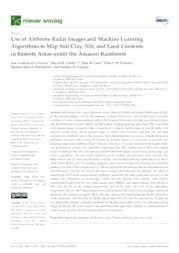Use of airborne radar images and machine learning algorithms to map soil clay, silt, and sand contents in remote areas under the Amazon rainforest.
Use of airborne radar images and machine learning algorithms to map soil clay, silt, and sand contents in remote areas under the Amazon rainforest.
Author(s): FERREIRA, A. C. de S.; CEDDIA, M. B.; COSTA, E. M.; PINHEIRO, E. F. M.; NASCIMENTO, M. M. do; VASQUES, G. M.
Summary: Soil texture has a great influence on the physical-hydric and chemical behavior of soils. In the Amazon regions, due to the presence of dense forest cover and limited access to roads, carrying out surveys and mapping of soils is challenging. When data exist, they are relatively sparse and the distribution is quite uneven. In this context, machine learning algorithms (ML) associated with remote sensor covariates offer a framework to derive digital maps of soil attributes. The objective of this study was to produce maps of surface and subsurface soil clay, silt, and sand contents in a 13.440 km2 area in the Amazon. The specific objectives were to a) evaluate the gain in prediction accuracy when using the P-band of airborne radar as a covariate; b) evaluate two sampling approaches (Reference Area-RA and Total Area-TA); and c) evaluate the transferability and performance of three ML algorithms: regression tree (RT), random forest (RF), and support vector machine (SVM). The study site was divided into three blocks, called Urucu, Araracanga, and Juruá, respectively. The soil dataset consisted of 151 surface and subsurface sand, silt, and clay observations and 21 covariates (20 relief variables and the backscattering coefficient from the P-band). Both the RA and TA sampling approach used 114 observations for training the prediction models (75%) and 37 for validation (25%). The RA approach was better for the development of sand and silt models. Overall, RF derived the most accurate predictions for all variables. The effect of introducing the P-band backscattering coefficient improved the sand prediction accuracy at the surface and subsurface in Araracanga, which had the highest sand content, with relative improvements (RI) of the R2, root mean square error (RMSE), and mean absolute error (MAE) of 46%, 3%, and 4% at the surface, respectively, and 66.7%, 4.4%, and 5.2% at the subsurface, respectively. For silt, the P-band improved the predictions at the surface in Araracanga, which had the lowest silt contents among the blocks. For clay, adding the P-band improved the RF predictions at the subsurface, with RI of the R2, RMSE, and MAE of 29%, 5%, and 5%, respectively. Despite the low observation density, inherently hindered by the low accessibility of the area and high costs of sampling thereof, the results showed the potential of ML algorithms boosted by airborne radar P-band to map soil clay, silt, and sand contents in the Amazon.
Publication year: 2022
Types of publication: Journal article
Unit: Embrapa Soils
Observation
Some of Embrapa's publications are published as ePub files. To read them, use or download one of the following free software options to your computer or mobile device. Android: Google Play Books; IOS: iBooks; Windows and Linux: Calibre.
Access other publications
Access the Agricultural Research Database (BDPA) to consult Embrapa's full library collection and records.
Visit Embrapa Bookstore to purchase books and other publications sold by Embrapa.

